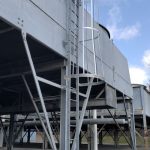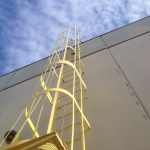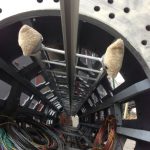Working with Fixed Ladders – A Need For Fall Protection
 A common item found throughout many workplaces is the fixed ladder and it can be easily overlooked until the time comes when it is needed. We may pass by them each day without much thought, but when the time comes and the ladder is needed, we want to be sure we are protected. OSHA put out new safety guidelines in January of 2017 for all fixed ladder systems in the new Walking -Working Surfaces Standard to help provide more protection for you, the workers of America. All general industries are affected by the changes and revisions to the guidelines for fall protection systems and other safety features.
A common item found throughout many workplaces is the fixed ladder and it can be easily overlooked until the time comes when it is needed. We may pass by them each day without much thought, but when the time comes and the ladder is needed, we want to be sure we are protected. OSHA put out new safety guidelines in January of 2017 for all fixed ladder systems in the new Walking -Working Surfaces Standard to help provide more protection for you, the workers of America. All general industries are affected by the changes and revisions to the guidelines for fall protection systems and other safety features.
No More Ladder Cages
The largest and most noticeable change to the standards is the elimination of the traditional safety cage as an acceptable form of fall protection. Other small adjustments have been made as well such as the rung spacing, proper clearances, ladder design elements, and the step across distance, but the phasing out of wells or cages is the predominant change. In the past safety cages have been viewed as controversial and their effectiveness in total have been questioned. While they do provide relief in situations where workers may need to position themselves in a resting state, the new standards provide more in the terms of fall protection.
Fixed Working Ladders – OSHA Regulation Changes
 Here, we will lay out the changes as simply as we can to keep everyone up to date and hopefully provide some clarification on the issue. The following are the key changes put into place with the new standards:
Here, we will lay out the changes as simply as we can to keep everyone up to date and hopefully provide some clarification on the issue. The following are the key changes put into place with the new standards:
- All fixed ladders (that extend more than 24 feet) installed on and after November 19, 2018, is equipped with a personal fall arrest system or a ladder safety system. Please note that cages sold or installed after November 19, 2018 are no longer considered a form of fall protection. Cages installed prior to this date are still accepted as a form of protection until the final deadline of November 18, 2036.
- Each fixed ladder that extends more than 24′ above a lower level that is installed before November 19, 2018, should be equipped with a personal fall arrest system, cage or well. The previous height requirement for fall protection was previously 20′. This has now been increased to 24′.
- When a fixed ladder, cage, or well, or any portion of a section thereof, is replaced (on and after November 18, 2018), a personal fall arrest system or ladder safety system is installed in at least that section of the fixed ladder, cage, or well where the replacement is located.
- On and after November 18th 2036, all fixed ladders (that extend more than 24 feet) should be equipped with a personal fall arrest system or a ladder safety system. Although this is 20 years away, from prior experience the market typically adopts these changes quickly. November 18th 2036 is the final deadline that no cages are allowed as a form of fall protection.
As the industry adapts to these changes, it is crucial that you ensure all aspects of your ladder safety approach are supporting safe worker operation and behaviors.
Working Ladders Fall Protection Summary
 In summary, new fixed ladders installed after November 19th, 2018 at heights of 24’ or greater will require a personal fall arrest system. Fixed ladders installed before November 19th, 2018 should be equipped with a cage or fall protection system. As of November 18th, 2036 all fixed ladders above 24’ will be required to have a personal fall arrest system like a vertical track or cable lifeline. Different conditions may call for different variations of vertical fall protections systems, but they should always allow movement up and down the entire height of the ladder without having to disconnect or find different tie off points along the way. Protecting American workers is our priority and we are here to offer assistance in any way we can. New Standards will always mean new questions, but our team is here for you.
In summary, new fixed ladders installed after November 19th, 2018 at heights of 24’ or greater will require a personal fall arrest system. Fixed ladders installed before November 19th, 2018 should be equipped with a cage or fall protection system. As of November 18th, 2036 all fixed ladders above 24’ will be required to have a personal fall arrest system like a vertical track or cable lifeline. Different conditions may call for different variations of vertical fall protections systems, but they should always allow movement up and down the entire height of the ladder without having to disconnect or find different tie off points along the way. Protecting American workers is our priority and we are here to offer assistance in any way we can. New Standards will always mean new questions, but our team is here for you.

